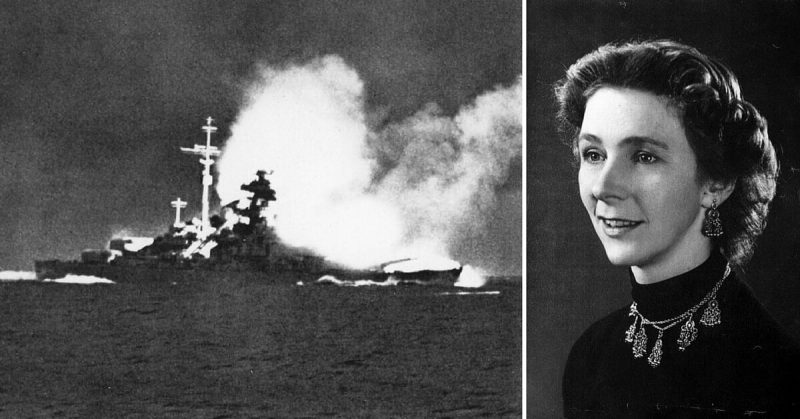Jane Fawcett passed away on May 21st, 2016, at her home in Oxford, England. She was 95 years old.
Fawcett was a young London society woman when she began working at Bletchley Park, the headquarters of Britain’s code-breaking efforts in World War II. She is credited with identifying the message that led to the sinking of the German battleship Bismark.
After the war, she went on to a career as a singer and, later, worked in heritage preservation. Her lasting legacy, however, is as the sharp-eyed British wartime decoder.
Germany’s mightiest battleship in 1941 was the Bismark. In May of that year, it became a prime target of the Allies after it sunk one of the most powerful vessels in the British navy, the battlecruiser Hood. Much of the British fleet was devoted to finding and destroying the Bismark, which was thought to have withdrawn to the North Atlantic in the vicinity of Norway.
Fawcett, who was Jane Hughes at the time, was 20-years old and working at Bletchley Park, the estate in Buckinghamshire, north of London, where the Government Code and Cypher School was located.
Thousands of young women worked there during the war. Many were like Fawcett, recruited from the upper strata of British society. They performed a variety of tasks, mostly assisting the male team members who were struggling to decode the German military missives written by code machines such as the Enigma device.
The Enigma machine generated new codes daily and, while the Allies had achieved some success in decoding them, it was still laborious work and results were unpredictable, requiring a chain of vigilant workers. Fawcett worked in Hut 6, which focused on breaking codes from the German Army and the Luftwaffe, the German air force.
In Michael Smith’s 2015 book, The Debs of Bletchley Park and Other Stories, he describes her station. She worked at a Typex that was modified to replicate an Enigma machine. When the daily code was broken, either she or another woman in the decoding room would receive the keys and type out the encoded messages.
The Typex would print out the decoded message and Fawcett and her co-worker would then check to see if the message was readable German. She had learned the language during her time in Switzerland. The German messages were then passed along to Hut 3, where they would be included in intelligence reports.
On May 25, 1941, she was briefed with the others about the Bismark. “We all knew we’d got the fleet out in the Atlantic trying to locate her because she was the Germans’ most important, latest battleship and had better guns and so on than anybody else, and she’d already sunk the Hood,” Ms. Fawcett recalled in the book. “So it was vitally important to find where she was and try to get rid of her.”
Just over an hour into her shift, Fawcett typed out a message from the main Luftwaffe Enigma machine. She recognized that the decoded message was a reply to a German general who had inquired about the health of his son who was on the Bismark. The response indicated that the Bismark had been damaged and was on its way to the port of Brest, in Brittany, France, for repair.
The message was instrumental in finding the Bismark. It was spotted by a seaplane, attacked by aircraft carrier torpedo bombers, and swarmed by Royal Navy battleships and cruisers. It was sunk in the Atlantic west of Brest on May 27.
Janet Carolin Hughes was born on March 4 , 1921 – most likely in Cambridge, where her paternal grandmother lived, although her family lived in London. Her father, George Ravensworth Hughes, was a lawyer in the Goldsmiths’ Company guild. Her mother, formerly Peggy Graham, did charitable work as a prison visiter.
The young Jane dreamed of becoming a ballet dancer and trained for a year at Sadler’s Wells. At 17, she was determined as too tall for the company; her parents sent her to Switzerland as a consolation. She spent six months there studying German. Her mother called her back for debutante season, deciding that it was time for her to come out in society.
Resentful of having to return to London, in 1940 she applied to work at Bletchley after hearing from a friend who was already working there. She signed the Official Secrets Act, which compelled her to keep her work to herself, and was assigned to Hut 6. She told her parents that she had joined the Foreign Office supporting British interests abroad, even though she was only 50 miles from home.
“It was very bad accommodation,” she recalled in The Debs of Bletchley Park. “Very cold in the winter and very hot in the summer. No insulation of any kind except for blackout curtains. We had horrid little trestle tables, which were very wobbly, and collapsible chairs, which were also very wobbly, very hard. There was very poor lighting; single light bulbs hanging down from the ceiling. So we were really in semidarkness, which I expect is what the authorities wanted, better security.”
After the war, she trained as a singer at the Royal Academy of Music. She toured as a recital and opera singer throughout the 60s. She joined the Victorian Society, which was formed to protect Victorian-era buildings. She once won a famous battle against British Railways to save the St. Pancras train station in London and the Midland Grand Hotel beside it. She also taught building preservation at the Architectural Association School of Architecture.
She met her husband, Edward Fawcett (called Ted), at a luncheon arranged for young naval officers so they could meet young women. The two were married just after the war. Mr. Fawcett worked as director of publicity for the National Trust, a British charity that works to conserve and protect historic sites. He died in 2013.
Jane Fawcett is survived by her son, James Fawcett, her daughter Carolin Comberti, and five grandchildren.
